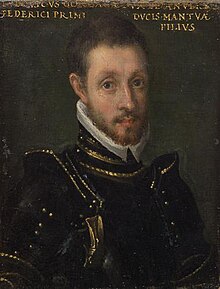
Back Лудовико Гонзага Bulgarian Ludovico Gonzaga-Nevers Breton Lluís I Gonzaga-Nevers Catalan Ludvík Gonzaga, vévoda z Nevers Czech Luigi Gonzaga German Λουδοβίκος του Νεβέρ Greek Luis Gonzaga-Nevers Spanish Louis IV de Gonzague-Nevers French Ludovico Gonzaga-Nevers Italian ルドヴィーコ・ゴンザーガ=ネヴェルス Japanese
Louis de Gonzague | |
|---|---|
| jure uxoris Duke of Nevers | |
 Anonymous portrait of the duke | |
| Born | 18 September 1539 Mantua |
| Died | 23 October 1595 (aged 56) Nesle |
| Noble family | House of Gonzaga |
| Spouse(s) | Henriette de Clèves |
| Issue |
|
| Father | Federico II Gonzaga |
| Mother | Margaret Palaeologina |
Louis de Gonzague, Duke of Nevers (Italian: Ludovico or Luigi di Gonzaga-Nevers; 18 September 1539 – 23 October 1595) was a soldier, governor and statesman during the French Wars of Religion. His father and brother were reigning dukes of Mantua. He came to France in 1549, and fought for Henri II of France during the latter Italian Wars, getting himself captured during the battle of Saint Quentin. Due to his Italian connections he was seen as a useful figure to have as governor of French Piedmont, a post he would hold until Henri III ceded the territory in 1574. In 1565 his patron, Catherine de' Medici secured for him a marriage with the key heiress Henriette de Clèves, elevating him to duke of Nevers and count of Rethel. He fought for the crown through the early wars of religion, receiving a bad injury in the third war. At this time he formed a close bond with the young Anjou, future king Henri III, a bond that would last until the king's death.
He opposed any drive to war with Spain in 1572, and after the attempt on Admiral Coligny's life was a key member of the council that decided on the policy of elimination for the Protestant leadership. A radical Catholic, he revelled in his involvement in the Massacre that unfolded in the subsequent days. In the fourth war of religion he was the de facto leader of the siege of La Rochelle but was unable to bring it success. In the fifth civil war his army shadowed that of the duke of Alençon brother of the new king Henri, not giving battle, but containing him until Catherine negotiated a settlement. Nevers was disgusted with the generous Peace of Monsieur that concluded the civil war, joining the ligue movement that spread in the wake of it among radical Catholics, and campaigning for the resumption of war which was soon achieved. He now acted in the sixth civil war as the de facto leader of Alençon's now loyal army, campaigning brutally along the Loire, sacking La Charité-sur-Loire and Issoire, the war concluding in the harsher Treaty of Bergerac.
Nevers was again tempted to join the ligue during the second wave of the movement after the death of Alençon. Briefly serving as a commander for their forces in 1584, before he was pealed off from the movement in 1585 and returned to loyally supporting Henri. In 1588 he was chosen to replace the Prince of Condé as governor of Picardie. He would try and fail to receive the submission of several ligue towns in the governate for the king. In 1589 he would be replaced in the governate, and granted the role of governor of Champagne instead, a role he held in the name of his son. After the assassination of the Duke of Guise he was courted by the insurgent ligueurs in Paris who wanted to bring him over to the cause, but he rebuffed their advances. He virulently urged the king in the chaos that followed, not to come to terms with his heir Navarre but the king refused his advice, and formed an alliance, despite this Nevers remained loyal. On the death of the king, he again flirted with the ligue before committing himself to Henri IV serving him in Champagne, and then in failed diplomatic negotiations with the Pope after his abjuration from Protestantism. After briefly serving on his financial council, he died in 1595.